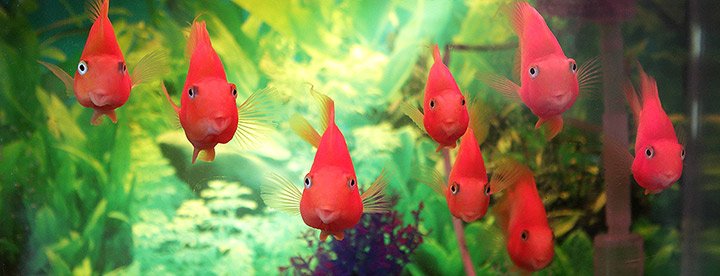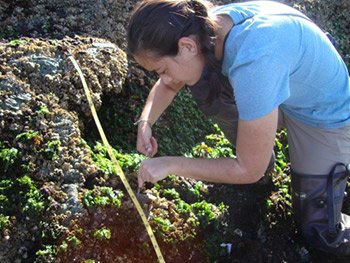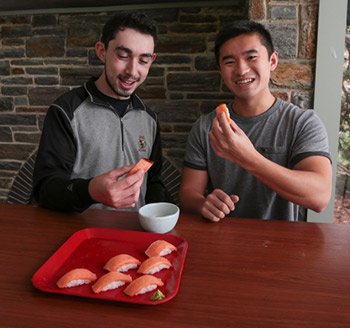24 Ways to Look at a Fish

On assessing everything anew through the limitless lens of the liberal arts
Six blind men, so the story goes, sought to define by touch what an elephant was. Each offered a different interpretation based on the body part he felt: trunk, side, ear, leg, tusk, tail. All were right, yet all were wrong.*
Elephant-touchers all, we would do well to remember this parable’s wisdom. According to the following community members, we can never be too curious about the world around us; we should never take anything in it for granted, no matter how seemingly mundane. It’s an excellent reminder of the power of a place like Swarthmore, where there are as many ways to look at something—an elephant, a problem, the future, a fish—as there are Swarthmoreans.
After all: The way we look at a fish says little about the animal … but everything about us.
(*Six blind elephants, so a better story goes, sought to define by touch what a man was. “Flat,” they agreed.)
2
“I respect fish enough not to eat them—the way and conditions in which they are farmed in America are pretty horrendous, and I’m not optimistic about how they are treated across the world, either,” says animal-rights activist and vegetarian Daniel Paz ’17. “How can anyone think it’s humane to pierce a fish with a hook, yank it out of the water, then either kill it, wait for it to asphyxiate, or toss it back?”
4
 “I had never seen a tidepool before,” says Grace Farley ’17, who completed a summer research project on anemone behavior. “Observing so many different critters living in them was magical.”
“I had never seen a tidepool before,” says Grace Farley ’17, who completed a summer research project on anemone behavior. “Observing so many different critters living in them was magical.”
Fascinated by marine biology since the fourth grade, Farley wants to continue her studies. “People’s lives and entire economies rely on our relationship to fish and aquatic creatures,” she says. “Better understanding them and the whole cycle of how the ocean works is crucial to appreciating and protecting it.”
11
“I named my fish Lola after the Kinks song,” says soon-to-be-science-teacher Amit Schwalb ’17 of his male betta, “because I wanted her to be trans so I could relate to her.”
His mother’s hasty replacement for a pet fish she accidentally killed—“She forgot I’d notice Pablo was blue and Lola was red”—Lola slowly swam into Schwalb’s heart.
He played guitar and sang to her in the dorm; she accompanied him to class, to Sharples, and even on road trips in a travel container.
“Ultimately, we’re all just projecting onto our pets, and I would laugh and think, This is almost performance art,” Schwalb says. “But I genuinely developed an emotional connection with her.”
In front of her “diva” fish bowl decoration and beneath posters of Madonna, Emma Goldman, and Angela Davis, Lola bore witness to some of Schwalb’s most formative years; when she died, he buried her in the northwest corner of West Philadelphia’s Clark Park.
“She was a big part of my life,” he says. “A little fish named Lola was worth caring about. We all are.”
12
 “Sushi is a beautiful art of fine details,” says Henry Han ’20. “It takes practice and precision.”
“Sushi is a beautiful art of fine details,” says Henry Han ’20. “It takes practice and precision.”
Arriving on campus with some sushi-chef training, Han teamed with Natasha Markov-Riss ’20 to open Late Nite, an immensely popular after-hours Swarthmore sushi dorm-delivery service. (Max Katz-Balmes ’20, left, helps with deliveries; Han made sure to secure a food handler’s license.)
“Sushi also brings to mind overfishing—ahi tuna could be extinct in 20 years,” he says. “Maybe my thing will be innovating sustainable ways to make sushi.”
21
“Samak Mashwi”
A poem by Nader Helmy ’17
I talk a really good game but to be
frank, I didn’t really care for Finding Nemo
(unpopular opinion can topple a whole metropolis)
I suppose that’s my inability to empathize
with a loss that resolves itself too quickly
(I needed a sequel toward some burdened light)
I am swimming in the Red Sea before I can count
and my whole world are the critters kissing my ankles
(there is no suffering here, just me and the crew)
We all gotta eat so eventually, we depart from the coast
course correct to the feast, family eating the crew
(from afar the market sets up a circus in the nostrils)
Before we sit down, our critter friends wait for us
on the table, half a crispy brown sheen glistening
(half charred skin blackened flakes like shingles)
Eyes gouged out, mouth agape, skeleton intact
I get it when we squeeze the lemon on top
(greens from the earth, meat from the sea, the elements)
Still me daydreaming about the friends I’ve yet to meet
deep sea monsters, wading, one with the still blackness
(me kissing their ankles / the closest analogue on their body)
Spiky horns, lizard lions, cyclops squids, animated coral
all part of the sea, married to the ocean like us
(we the lost children of diaspora dumped by the mainland)
We have always been an agile species, darting through
the water, surviving despite the odds against us
(depriving this infant evolution of the oxygen it needs)
And so there is calm and light amidst the constant thunder
our people giving proper honors for the struggle of the crew
(blackened scales, flaking abyss with hollow eyes bone-in)
Find more of the 24 Ways to Look at a Fish from faculty, staff, and alumni in The Bulletin.


